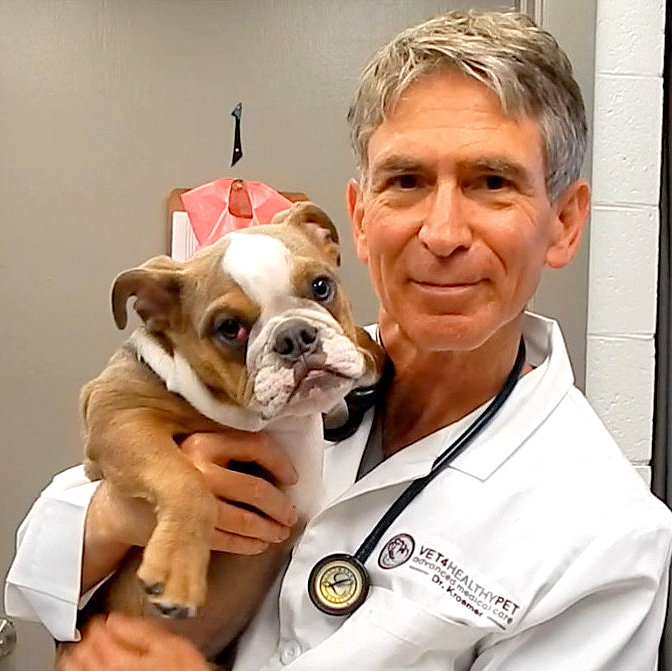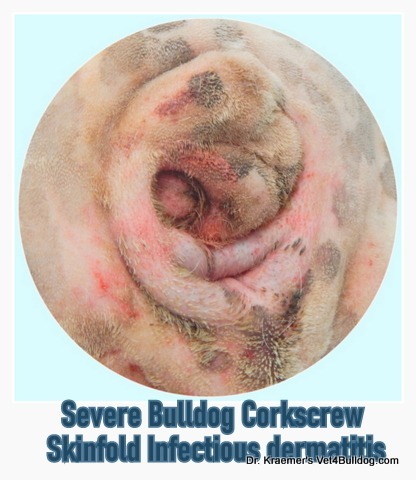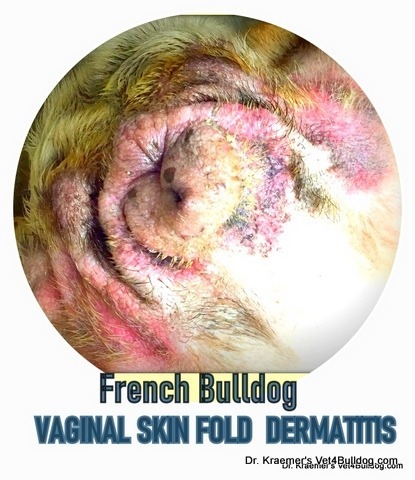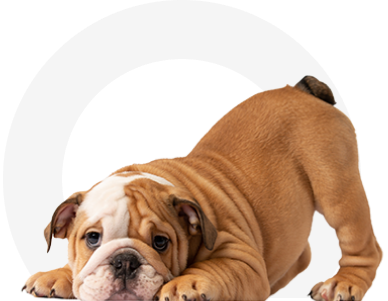Subject: Seeking Relief for Buster’s Scooting Woes 🐾😟 #BulldogHealth #scooting
Dr. Kraemer, I’ve noticed a concerning issue with Buster, he has been exhibiting some discomfort around his rear end, scooting more than usual and occasionally licking at his hindquarters. Recently, I detected a distinct odor, and upon closer inspection, I think there might be swelling or tenderness around his buttocks.
Warm regards, Jasmine T. & Buster 🐶💖 #BulldogMom #itchyscoot
Introduction to Anal Gland Disease in Bulldogs:
Let’s be real—anal gland issues aren’t exactly a glamorous topic, but they’re super common in bulldogs and can cause major discomfort. When those little glands get blocked, your pup can feel itchy, sore, and downright miserable. Left unchecked, things can get worse—think infection, abscesses, and even rupture (yes, it’s as bad and smells as it sounds).
The good news? You can help prevent all that drama with a few simple steps:
- Keep your bully at a healthy weight
- Add high-quality fiber supplements made just for bulldogs
- Feed a balanced, allergy-friendly diet
- Stay on top of tail pocket care (hello, no more hidden irritation!)
- Manage allergies and skin itch
- Go on daily walks and keep the body moving
A little booty care goes a long way—and your bulldog will thank you with fewer scoots and more snuggles!
ANAL GLAND DISEASE TYPES
- Impaction
- Infection and Abscess
- Rapture
- Tumor
What is The Cause Of Anal Gland Impaction?
Anal gland problems occur when their normal drainage is impaired, on those occasions, they become
- swollen
- impacted
- infected
- abscessed
- and diseased.

Bulldog Anal Gland 5 MUST KNOW!
- The glands are embedded on the two sides of the rectum (anus).
- Obstructed anal ducts lead to infected abscesses that can rupture.
- Anal gland disease often presents as bloody, smelly, purulent, secretions, and butt scooting.
- Treatment includes expressing (emptying) the glands, medication, bully therapeutics, and surgery.
- Prevention includes Dr. Kraemer’s Anal Gland V4B therapeutics.
The owners of this bulldog community prefer prevention over RX
What Is Th Anal Gland Anatomy?
Your bulldog’s anal glands are embedded in the muscles of the anus, making them not readily visible.
Each of the paired glands has its glandular sac and attached ducts that normally empty into the rectum during defecation.
What is The Anal Glan Function?
The current medical purpose of these glands is not clear. Back in their wild, pre-domesticated days, dogs used them to mark territory and identify each other by scent (yep, that’s likely why dogs are so into butt sniffing). While they’re not super useful anymore, these little scent sacs can still cause big issues, so they’re definitely worth understanding and managing.
Anal glands are notorious for their oily, pasty, grey-colored residue that permeates with a pungent, unpleasant odor.
Why does Anal Gland Have a Bad Funky Smell?
Think of anal glands like a bully business card. The unique scent acts as a calling card, marking territory and announcing a dog’s presence to passing dogs.
This way, they could
- claim their turf
- navigate their social hierarchy
- even find potential mates

BULLDOG ANAL GLAND ID CARD:
Beyond territory, the distinct scent offered another benefit: a doggy ID tag.
By sniffing each other’s rear ends, dogs could gather valuable information about one another, like:
- age
- sex
- and even health status.
The anal glands likely play a vital role in their social interactions. While pre- and early domestication are gone, as are many of the functions they served, they are still there and, at times, can cause problems.

What is Anal Glands Disease in Bulldogs Symptoms?
There could be several ways that anal gland disease can present, some are mild and others are more dramatic. It could be on both sides or just on one side. Some of the most common manifestations of impaction and disease are:
- SCOOTING: Dragging the back end on the floor
- BITING & ITCHING: trying to bite the back end
- FUNKY SMELL: Some owners will describe it as “yeasty” or “fishy”.
- REDNESS: Redness of the perianal area due to self-trauma and inflammation
- PAIN: Crying in pain, biting their hind end
- DEPRESSION: Stop eating; act irritable
- DRAINAGE: usually bloody, pasty discharge
Bulldogs and French Bulldogs Anal Gland DISEASE TYPE:
The most common types are:
1. ANAL GLAND IMPACTION
Impaction is the most common bulldog anal gland problem. It usually presents as
- red bump
- itchy butt
- scooting
2. ANAL GLAND SACCULITIS
Sacculitis (inflamed sac) is a complicated form of anal gland impaction. It usually presents as:
- redness
- swelling
- pain
3. BULLDOG ANAL GLAND ABSCESS:
An abscess is an infected, inflamed anal gland. It usually presents as:
- major swell
- very painful
- bright red to raw
- often rupture (open wound)
- bloody and discharge
4. ANAL GLAND TUMOR:
On rare occasions, the sac can become cancerous. The most common anal gland tumor is adenocarcinoma. It is more common for aging dogs will present as:
- If sizeable, it could impede defection
- Bleeds
- Abcesse
- Painful
Is Anal Gland Impaction Painful?
Yes, anal gland impaction, disease, and abscess can be itchy and painful. During the acute phase, pain medication might be required.
➡️Dr. Kraemer’s Bully Comfort & AchLess Supplements to help relieve discomfort

How To Prevent Bulldog Anal Glands Impaction?
Prevention is preferred over treatment; it is less painful, safer, and cheaper.
1. ANAL GLAND WEIGHT LOSS
Obesity could be related to chronic anal gland problems; weight will often help prevent it.

2. BEST FOOD FOR ANAL GLAND
A diet that combines high-fiber elements may contribute to more robust, more frequent, and complete bowel movements, potentially serving as a “natural” method for expressing anal glands.
3. ANAL GLAND THERAPEUTIC SUPPLEMENTS:
Bulldog botanical fiber is an excellent anal gland therapeutic
Botanical natural fibers can help relieve the gland and prevent
- Anal gland impaction
- Anal gland abscess
- Lower-bowel diseases that are responsive to fiber
- Bulldog colitis
🌿Dr. Kraemer’s V4B Bully Gentle Move & Anal Gland Care
4. BULLDOG ANAL GLAND HYGIENE:
Keeping the perineal area clean can prevent irritation to the area, itching, and rubbing that can cause trauma to the anal gland and sac. Wiping the area with the therapeutic bully antiseptic XL wipes can help maintain an itch-free healthy perianal “butt area”
5. PREVENTING BULLDOG TAIL POCKET DISEASE:
Similar to perineal dermatitis, itching scooting, and rubbing an infected tail pocket skinfold moist dermatitis must be prevented and daily treated with Dr. Kraemer Bully Antiseptic Skinfolds XL Wipes to help avoid trauma and injury to the nearby anal glands and sac.
6. BULLDOG ALLERGY PREVENTION:
Allergies of all kinds, especially ones around the butt, tail, dorsum, and back legs cause acute and chronic itch leading to secondary infection that leads to trauma and infection of the anal gland and sac.
- Flea Allergy
- Food Allergy
- Atopic Allergy

How To Treat Anal Gland Disease?
Treatment depends on the underlying disease, severity, degree of pain, and chronicity.
1. ANAL GLAND IMPACTION SELF-CARE:
While most bulldog and French bulldog owners choose to have their dogs’ glands expressed by an experienced veterinary team member, for the adventurous bulldog owner seeking “fame & glory,” attempting it at home is an option.
- GLOVE: Place a disposable glove on your hand; anal gland residue is not pleasant.
- KY JELLY: Place a lubricant on the fingers if attempting to express rectally.
- TEAMWORK: Most times, you will need someone to hold your dog and keep her or him upright.
- DIGIT:
- Insert one-third of your thumb (for right anal gland) or index finger (for left AG) into your dog’s rectum fingernail deep
- Use your respective thumb or index finger and press the outer wall.
- Move the rectal finger up and down between 4-5 o’clock (rt) or 7-8 o’clock (left) and try to locate a pea to grape size bump.
- SQUEEZE: Try and squeeze it; you should feel anal gland contents coming out.
- INSPECT: Check your rectal finger for residue and inspect it for abnormalities and blood.
- WIPE: Wipe the area with a
- FREQUENCY: Each bulldog’s needs are different. You can check the status every two weeks and if the gland is empty extend it to once every 4 weeks
2. ANAL GLAND IMPACTION MEDICAL CARE
Bulldog anal gland impaction is the most common anal gland problem seen by the veterinary team. An experienced team member can manually express the bulldog’s impacted anal glands and relieve the impaction.
➡️Expressing anal glands should be done rectally.
3. ANAL GLAND TREATMENT UNDER ANESTHESIA
In some cases, sedation might be required, for the reasons:
- ABSCESS: Repair ruptured anal gland abscess
- PAIN: too painful to be expressed awake
- MEDICATE: Flush and medically pack the duct and gland
- FNA: Fine needle aspirate for cytology for suspected tumor.

4. ANAL GLAND PRESCRIPTION RX
A more advanced disease, such as an abscess, might require prescription medication such as
- Antibiotics: for abscesses or infected glands
- Pain Relief: such as NSAIDs and other prescription analgesics
- Anti-Inflammatory medications, such as cortisone and NSAIDs
5. ANAL GLAND BULLY THERAPEUTICS:
Adding therapeutic supplements help treat anal gland diseases
- Natural anti-inflammatories Bully Fish Oil Immune-Joint-Skin Chews
- Anal gland emptying: Natural botanical fibers Bully Gentle Move & Anal Gland Health Chews
🌿Dr. Kraemer’s “Gentle Move & Anal Gland Care” are palatable chews that are easy to administer as treats.
Anal Gland Sacculectomy Surgery
At times, surgical removal of the anal gland surgical recommended (sacculectomy).
Reasons for this could be:
- Chronic recurrent anal gland infection
- Tumor of the Anal Glands
Precaution should be taken not to injure the anal rectum sphincter that will lead to lifelong fecal incontinent

Bulldog Anal Gland Tips & Warnings
Below are essential anal gland disease tips and warnings course by Dr. Kraemer
#1 RECTAL EXAM TIP:
When performed rectally, a veterinary team member can assess whether the gland is full, empty, and expressible. If recently expressed, we can confirm that the gland is indeed empty.
#2 NON-RECTAL ANAL GLAND EXPRESS TIP:
When conducted externally (non-rectally), as commonly performed by most groomers, it becomes challenging to ascertain whether the glands are empty or full. It is not uncommon for a groomer to mistakenly assert that the glands are in good condition merely because nothing was expelled during the expression process, when, in fact, they might be impacted.
🚨Furthermore, external expression does not guarantee complete evacuation of the glands.
#3 ANAL GLAND, BUTT & PERIANAL TIP:
Scooting, biting, and itching of your bulldog’s back end is often an anal gland disease but keep in mind that it also can be due to:
- Bulldog Tail Fold Dermatitis
- Bulldog Anal Gland Impaction
- Bulldog Vaginal Fold Dermatitis (female)
- Bulldog Flea Allergy
- Bulldog Other Allergy
- Bulldog Whipworms
#4 BULLDOG SKIN FOLD DERMATITIS TIP:
The anal gland odor is often described as a “Yeasty or Fishy Smell”.
Severe bulldog skin fold dermatitis can such as vaginal fold dermatitis and tail pocket dermatitis have a similar smell; thus, make sure to examine them
🚨Both should be wiped with Dr. Kraemer’s bully V4B antiseptic wipe.
#5 ANAL GLAND PREVENTIVE CARE TIP:
Familiarize yourself with your bulldog’s back end (tail, rectum, perianal area, vaginal folds) and adhere to my “Zen & Bulldog Maintenance” preventive program that includes
- WIPE: Regular wiping with bully antiseptic wipes
- EXPRESS: Manual digital rectal emptying of the glands
- PREVENT: Providing natural ache relief, anti-inflammatory, and anal gland-emptying supplements.
#6 DR. VISIT ANAL GLAND EXAM TIP:
If you suspect an anal gland problem, see your vet before it turns into a bigger problem.
#7 RECTAL DIGITAL EXPRESS TIP:
Expressing anal glands in bulldogs should be done rectally; when done from the outside, one cannot tell if they are empty.
When done rectally, the team member can feel if the gland is full or empty and if it is expressible.
#1 NON-RECTAL ANAL GLAND EXPRESS WARNING:
When conducted externally (non-rectally), as commonly performed by most groomers, it becomes challenging to ascertain whether the glands are empty or full. It is not uncommon for a groomer to mistakenly assert that the glands are in good condition merely because nothing was expelled during the expression process, when, in fact, they might be impacted.
#2 ANAL GLAND PAIN WARNING:
Expressing anal glands can be painful; at times, mild sedation is required.
#3 GROOMERS EXPRESSING ANAL GLAND WARNING:
Refrain from routinely expressing anal glands unless deemed necessary and medically indicated.
It is typically advised to avoid expressing the glands if your bulldog exhibits no symptoms of discomfort or has no history of anal gland disease, even though groomers or hospital staff may recommend or be asked to perform preventative anal gland examinations by pet owners.
While neglecting anal gland issues can cause pain and discomfort for your bulldog, the other extreme—frequent and unnecessary emptying—can also be detrimental. Overzealous expression can irritate the glands, increasing the risk of inflammation, infection, and even impaction (a hardened, painful blockage).
Remember, preventive care includes,
- weight management,
- quality diet
- bully therapeutic supplements
- skincare
- allergy care
- tail fold care
Prevention does not require frequent anal gland expression. Frequent and unnecessary expression can irritate the glands, causing inflammation, infection, and even impaction.
Healthy anal glands typically are emptied with regular, healthy bowel movements.
#5 BULLDOG TAIL FOLD WARNING:
Anal gland problems can compound bully tail fold dermatitis in bulldogs and French bulldogs suffering from tight, deep-pocketed, or corkscrew tails.
This might happen due to anal gland debris trapped in the fold and self-trauma due to itching and scooting.
#6 SEDATION WARNING:
Expressing anal glands can be painful; thus, at times, mild sedation is required. Sedation and anesthesia in bulldogs are a high risk, please read Dr. Kraemer’s warning on this subject HERE
#7 ANAL GLAND ABSCESS SURGERY WARNING:
Anal sac surgical removal should be reserved for tumors and severe chronic cases.
It should only be done by a surgeon familiar with the breed and experienced with the surgery
There are some potential risks, such as:
- ANESTHESIA: As for any surgical procedure
- INCONTINENCE: The anal glands are embedded near the anal sphincter. Scarring or injury to the nerves and muscles could lead to some degree of fecal incontinence.
- DRAINING TRACT: If the surgeon fails to remove all the glandular tissue or an infection of the surgical site occurs, an abscess with a draining tract will form, forcing a revision (cleanup) of the original surgery.
DR. KRAEMER’S FINAL ADVICE
Remember, the goal is to keep your bulldog’s anal glands healthy and functioning normally.
🚨Prevention is always preferred over medication, medical treatment, and surgery
ANAL GLAND PREVENTION CARE SUMMARY
- Exercise
- Stress-free environment
- A balanced, nutritious diet
- Lean body weight
- Proper hydration
- A sufficient fiber supplement
- Proper anal and perianal hygiene
- Proper tailfold hygiene
Recommended by Owners Approved by Bulldogs























